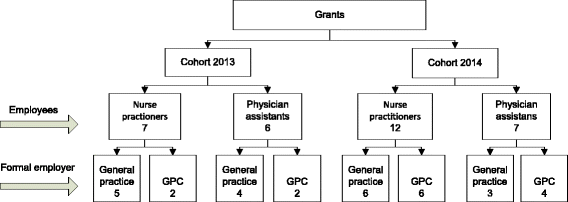Factors influencing decision of general practitioners and managers to train and employ a nurse practitioner or physician assistant in primary care: a qualitative study
- PMID: 28173766
- PMCID: PMC5297134
- DOI: 10.1186/s12875-017-0587-3
Factors influencing decision of general practitioners and managers to train and employ a nurse practitioner or physician assistant in primary care: a qualitative study
Abstract
Background: Due to the increasing demand on primary care, it is not only debated whether there are enough general practitioners (GPs) to comply with these demands but also whether specific tasks can be performed by other care providers. Although changing the workforce skill mix care by employing Physician Assistants (PAs) and Nurse Practitioners (NPs) has proven to be both effective and safe, the implementation of those professionals differs widely between and within countries. To support policy making regarding PAs/NPs in primary care, the aim of this study is to provide insight into factors influencing the decision of GPs and managers to train and employ a PA/NP within their organisation.
Methods: A qualitative study was conducted in 2014 in which 7 managers of out-of-hours primary care services and 32 GPs who owned a general practice were interviewed. Three main topic areas were covered in the interviews: the decision-making process in the organisation, considerations and arguments to train and employ a PA/NP, and the tasks and responsibilities of a PA/NP.
Results: Employment of PAs/NPs in out-of-hours services was intended to substitute care for minor ailments in order to decrease GPs' caseload or to increase service capacity. Mangers formulated long-term planning and role definitions when changing workforce skill mix. Lastly, out-of-hours services experienced difficulties with creating team support among their members regarding the employment of PAs/NPs. In general practices during office hours, GPs indented both substitution and supplementation for minor ailments and/or target populations through changing the skill mix. Supplementation was aimed at improving quality of care and extending the range of services to patients. The decision-making in general practices was accompanied with little planning and role definition. The willingness to employ PAs/NPs was highly influenced by an employees' motivation to start the master's programme and GPs' prior experience with PAs/NPs. Knowledge about the PA/NP profession and legislations was often lacking.
Conclusions: Role standardisations, long-term political planning and support from professional associations are needed to support policy makers in implementing skill mix in primary care.
Keywords: General practitioner; Implementation; Nurse practitioner; Physician assistant; Primary care; Skill mix; Substitution; Supplementation.
Similar articles
-
Skill mix change between general practitioners, nurse practitioners, physician assistants and nurses in primary healthcare for older people: a qualitative study.BMC Fam Pract. 2018 May 2;19(1):51. doi: 10.1186/s12875-018-0746-1. BMC Fam Pract. 2018. PMID: 29720099 Free PMC article.
-
Collaboration in teams with nurse practitioners and general practitioners during out-of-hours and implications for patient care; a qualitative study.BMC Health Serv Res. 2017 Aug 23;17(1):589. doi: 10.1186/s12913-017-2548-x. BMC Health Serv Res. 2017. PMID: 28830410 Free PMC article.
-
Towards an optimal composition of general practitioners and nurse practitioners in out-of-hours primary care teams: a quasi-experimental study.BMJ Open. 2017 May 30;7(5):e015509. doi: 10.1136/bmjopen-2016-015509. BMJ Open. 2017. PMID: 28559458 Free PMC article.
-
The influence of government policies on the nurse practitioner and physician assistant workforce in the Netherlands, 2000-2022: a multimethod approach study.BMC Health Serv Res. 2023 Jun 6;23(1):580. doi: 10.1186/s12913-023-09568-4. BMC Health Serv Res. 2023. PMID: 37280653 Free PMC article. Review.
-
Scale, scope and impact of skill mix change in primary care in England: a mixed-methods study.Southampton (UK): National Institute for Health and Care Research; 2022 May. Southampton (UK): National Institute for Health and Care Research; 2022 May. PMID: 35593786 Free Books & Documents. Review.
Cited by
-
Barriers and facilitators to the implementation of nurse's role in primary care settings: an integrative review.BMC Nurs. 2021 Sep 16;20(1):171. doi: 10.1186/s12912-021-00696-y. BMC Nurs. 2021. PMID: 34530813 Free PMC article.
-
Task shifting from general practitioners to practice assistants and nurses in primary care: a cross-sectional survey in 34 countries.Prim Health Care Res Dev. 2022 Sep 22;23:e60. doi: 10.1017/S1463423622000470. Prim Health Care Res Dev. 2022. PMID: 36134523 Free PMC article.
-
Barriers and facilitators to the implementation of doctor-nurse substitution strategies in primary care: a qualitative evidence synthesis.Cochrane Database Syst Rev. 2019 Apr 15;4(4):CD010412. doi: 10.1002/14651858.CD010412.pub2. Cochrane Database Syst Rev. 2019. PMID: 30982950 Free PMC article.
-
Yonder: Physician assistants, timewasting, nursing homes, and social media.Br J Gen Pract. 2017 Apr;67(657):176. doi: 10.3399/bjgp17X690317. Br J Gen Pract. 2017. PMID: 28360063 Free PMC article. No abstract available.
-
General practice managers' motivations for skill mix change in primary care: Results from a cross-sectional survey in England.J Health Serv Res Policy. 2023 Jan;28(1):5-13. doi: 10.1177/13558196221117647. Epub 2022 Aug 17. J Health Serv Res Policy. 2023. PMID: 35977066 Free PMC article.
References
-
- Laurant M, Harmsen M, Wollersheim H, Grol R, Faber M, Sibbald B. The impact of nonphysician clinicians: do they improve the quality and cost-effectiveness of health care services? Med Care Res Rev. 2009 - PubMed
-
- Vrijhoef HJ. The Wiley Blackwell encyclopedia of health, illness, behavior, and society. 2014. Nurse practitioners.
Publication types
MeSH terms
LinkOut - more resources
Full Text Sources
Other Literature Sources
Miscellaneous


